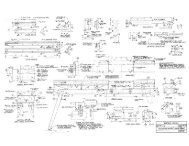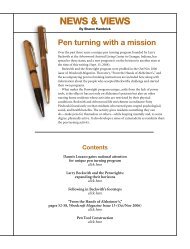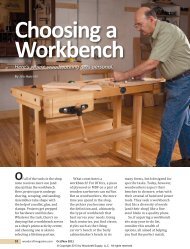42-Table Saw Safety3.indd - Woodcraft Magazine
42-Table Saw Safety3.indd - Woodcraft Magazine
42-Table Saw Safety3.indd - Woodcraft Magazine
Create successful ePaper yourself
Turn your PDF publications into a flip-book with our unique Google optimized e-Paper software.
on the table against the fence<br />
with its leading edge a few<br />
inches from the blade. Make<br />
sure the leading edge is flat on<br />
the table to prevent the blade<br />
from slapping it downward.<br />
With your left hand pressing<br />
the board against the fence<br />
and downward onto the table,<br />
put your right hand against<br />
the trailing end. (With a long<br />
board, grab the right-hand edge<br />
of the board instead, reaching<br />
as far back as you comfortably<br />
can.) Feed the board steadily<br />
forward into the spinning blade<br />
(Photo E). When the trailing end<br />
of the board is completely on<br />
the table, bring your pushstick<br />
into play while maintaining<br />
sideways pressure with your<br />
left hand (Photo F). As the<br />
cut nears completion, retract<br />
your left hand and continue<br />
feeding until the pushstick is<br />
past the splitter (Photo G).<br />
Featherboards<br />
A featherboard can be used<br />
instead of your hand to hold<br />
stock against the fence. Its<br />
flexible fingers are set at about a<br />
30° angle to allow easy feeding<br />
Featherboards<br />
Safe Ripping<br />
E<br />
G<br />
while impeding rearward<br />
motion. A featherboard is<br />
pretty good insurance against<br />
kickback but it’s no substitute<br />
for a properly aligned splitter<br />
or riving knife. That’s because<br />
F<br />
With your pushstick at the ready<br />
and the board flat on the table,<br />
feed with steady, even force<br />
while maintaining downward and<br />
sideways pressure with your left<br />
hand. When the trailing end of<br />
the board is on the table, switch<br />
to the pushstick for feeding,<br />
while keeping your left hand a<br />
safe distance from the blade.<br />
a featherboard can’t be located<br />
aft of the blade where it would<br />
pinch against the kerf. A<br />
featherboard can be mounted<br />
in the table slots (Photo H) or<br />
clamped to the table (Photo I).<br />
H<br />
When setting up a featherboard, press it firmly against<br />
the stock in front of the blade, and lock or clamp<br />
it in place. A slot-mounted unit is easiest to set.<br />
I<br />
Illustrations: Heather Lambert<br />
Aug/Sept 2011 woodcraftmagazine.com 41










